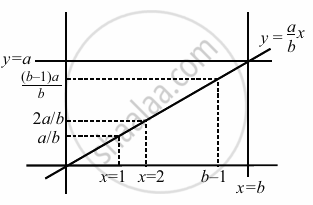Advertisements
Advertisements
प्रश्न
Let a and b are two positive integers such that b ≠ 1. Let g(a, b) = Number of lattice points inside the quadrilateral formed by lines x = 0, y = 0, x = b and y = a. f(a, b) = `[a/b] + [(2a)/b] + ... + [((b - 1)a)/b]`, then the value of `[(g(101, 37))/(f(101, 37))]` is ______.
(Note P(x, y) is lattice point if x, y ∈ I)
(where [.] denotes greatest integer function)
विकल्प
0.00
1.00
2.00
3.00
उत्तर
Let a and b are two positive integers such that b ≠ 1. Let g(a, b) = Number of lattice points inside the quadrilateral formed by lines x = 0, y = 0, x = b and y = a. f(a, b) = `[a/b] + [(2a)/b] + ... + [((b - 1)a)/b]`, then the value of `[(g(101, 37))/(f(101, 37))]` is 2.00.
(Note P(x, y) is lattice point if x, y ∈ I)
(where [.] denotes greatest integer function)
Explanation:

g(a, b) = (a – 1) (b – 1)
f(a, b) = `((a - 1)(b - 1))/2`
Now, `[(g(101, 37))/(f(101, 37))]`
= `((100 xx 36)/((100 xx 36)))/2`
= 2
